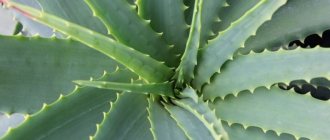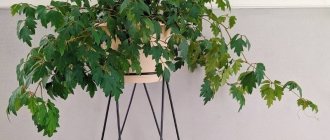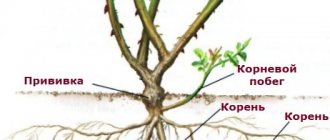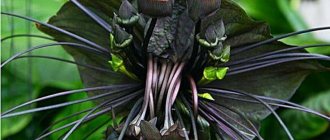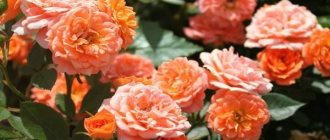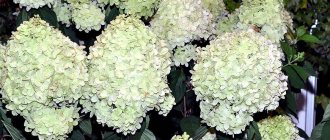Types and classification of winter-hardy roses
There is a modern classification that divides all frost-resistant varieties of roses into 3 groups:
- Absolutely winter-hardy flowers are also in an upright position in winter, withstanding the lowest temperatures and do not require special care;
- winter-hardy roses are also vertically positioned during wintering, but in severe frosts there is a tendency to freeze; average degree of stability do not require shelter in mild winters and freeze only to the level of snow, so they need to be bent.
The most winter-hardy roses - video
The highest frost resistance is present in park roses: winter-hardy varieties are represented by William Shakespeare, Westerland and others. They are ideal for growing in the central zone of the country, in particular in the Moscow region. BEAUTIFUL VARIETIES OF ROSES! Rose Versilia Climbing Rose Caesar Rose Pierre de Ronsard
Artificially bred roses in the form of Canadian hybrids, which are able to survive at temperatures of -45 degrees below zero without damage, can easily compete with them. They are also suitable for the northern regions, the Urals and Siberia.
Eyes for You
Sometimes this decorative variety of roses is confused with peonies due to the characteristic shape of the bud. The center of the flower is bright purple, but the main part of the petals is snow-white. A medium-sized bush up to 75 cm is resistant to heavy rainfall, powdery mildew and spotting.
Photo: gardengallereya.ru
How to choose roses for growing in Siberia and the Urals
The harsh climate of these regions dictates its own rules for choosing ornamental plants. Winters here are long, spring is late, warm days are rare. Seedlings should be purchased already adapted to such weather conditions. Unpretentious varieties of perennial roses for these regions are considered:
- Residence;
- Stadt rum;
- Popsicle;
- Larissa;
- Fairy;
- Sunny fairy tale;
- Jazz.
For the northwestern regions, it is better to choose creeping ground cover varieties of the following species:
- patios – low-growing, ridged, landscaped;
- floribunda - landscape, flower beds with abundant flowering;
- Canadian - Aisha, Queen of the North, Casanova, Abusta.
The last group is most preferable, since in Canada the climate is the same as in northern Russia. Roses grafted onto mother plants grown in Siberia or the Urals tolerate severe frosts well.
Note! Winter-hardy roses intended for cultivation in harsh climates must be resistant to pests and diseases
Angela
Bright crimson flowers look like deep bowls with a diameter of up to 6 cm, and their number almost does not depend on the degree of pruning. They bloom for a short time, but do not fade, and are not afraid of rain, pests and diseases. Angela is a hardy, frost-resistant rose that is reminiscent of ancient varieties.
Photo: oir.mobi
Remontant varieties
Remontant varieties differ from traditional hybrids by repeated flowering, but lower growth intensity. The bush reaches a height of about 2 m. The plants have large, beautiful inflorescences and are often frost-resistant.
This is important: How to insulate a rose for the winter
Abraham Darby
A low-growing crop, reaching a height and width of 1.5 m. The flowers are large, heavy, with a diameter of 8-14 cm. To prevent the branches from bending under them, supports are placed on them during the flowering period.
The inflorescences are densely double, soft apricot in color. In cold weather they take on a pink tone. The aroma is very subtle. Flowering continues from spring to autumn almost continuously. The plant has average frost resistance.
Feuewerk
The name fully justifies the color of the buds of this shrub variety. The flowers are semi-double, with wavy petals, and salmon-orange in color. They reach 8 cm in diameter and appear singly on branches. During the season, inflorescences appear several times.
The leaves are light green, glossy. The bush grows 2 m high and 1.3 m wide. It tolerates frost and rain well, so it is widespread in Europe and Russia. The culture is suitable for planting in public places and garden plots.
Frühlingsduft (Spring scent)
A spreading plant, reaching 2 m in height and width. The flowers are large, creamy yellow, up to 8 cm in diameter, collected in clusters of 5 pieces. A strong, refined aroma emanates from the buds. The leaves are light green, darkening closer to autumn.
How and when to feed roses so that they bloom magnificently, read the article
To describe this variety, such characteristics as frost-resistant, moisture-resistant, and almost not susceptible to diseases are quite suitable. Flowering is abundant, begins in early spring and continues until autumn.
Graham Thomas
A popular English variety of park roses. A fast-growing, medium-sized plant, reaching 1.5 m. The flowers are large, double, rich yellow, shaped like peonies.
The crop blooms throughout the summer. When grown in the middle zone, it showed resistance to frost and tolerates rain well. Since the inflorescences are quite heavy, the shoots have to be tied up or supported under them so that the branches do not break off.
Grand Hotel
A spreading powerful bush, reaching 2 m. The buds are red, almost purple, velvety, their diameter is 10 cm. The inflorescences are single, odorless, shimmering in various shades.
Buds appear throughout the summer and until late autumn. When they fade, decorative fruits ripen in their place. Plants are frost-resistant. They are usually planted in groups along a fence or trellis.
Rosa rugosa (wrinkled)
Medium-sized crop with thick gray-green shoots. The stems are covered with numerous thorns. The buds are purple, with a pinkish tint, and emit a clove aroma. Inflorescences appear before autumn, and small fruits ripen in their place.
The rose got its name from the shape of its leaves: they are wrinkled and shiny. The culture is hardy, unpretentious, almost never gets sick, resistant to drought and frost, and takes root well in urban environments. It is planted both singly and to form hedges.
Lichtkönigin Lucia (Light Queen Lucia)
The rose is medium-sized, with reddish-green shoots covered with thorns. Throughout the summer, double yellow inflorescences with a diameter of up to 10 cm appear on it. They are collected in brushes of 5 to 15 pieces.
Flowering is abundant and long lasting. The buds emit a pleasant, persistent aroma. The leaves are large, dark green, shiny. The crop is frost-resistant and is widely used in park plantings.
'Louise Odier
Bush up to 2 m high, with light green shoots. The inflorescences are double, light lilac, with a pink center. The buds are connected in brushes of 5-6 pieces. The plant has a strong aroma. It blooms profusely, the petals can be used for confiture. The variety is resistant to frost and diseases.
Westerland (Western)
A tall crop, reaching a height of 1.5 m, growing in width by 2 m. The main tone of the inflorescences is orange and peach. Depending on the weather, it may appear light yellow and pink tones.
The flowers are semi-double, large, up to 12 cm in diameter. The plant is resistant to rain and cold, flowering continues almost until frost. The variety is disease resistant and unpretentious.
Planting and care
Climbing roses - varieties of permanent flowering - prefer sunny areas located on the south side. Thanks to good lighting, the development of growth is accelerated, and already next summer after planting, abundant flowering can be observed. It is unacceptable to plant young plants in lowlands, as roses do not tolerate stagnant moisture.
Important! In cases where flowers are planted for the purpose of decorating an object, it is best to plant a seedling 50 cm from it. Experts advise planting bushes in the spring months at sunset. In autumn, seedlings do not have time to adapt and most often die
In autumn, seedlings do not have time to adapt and most often die
Experts advise planting bushes in the spring months at sunset. In autumn, seedlings do not have time to adapt and most often die.
Continuously blooming varieties of roses will decorate the area and do not require complex care.
Planting process:
- First of all, the holes are prepared, the size of which should be within 50x50 cm.
- The prepared hole is filled with water.
- The seedling is planted in a hole, which is filled with soil and compacted. If you trim the above-ground part of the plant by 15 cm, you can be sure of rapid growth and rich flowering in the future.
Important! If you still need to plant a bush in the fall, it is best to do this in September, when the rose has time to take root, but does not begin to grow. In the following years after planting, the seedlings do not require complex care, but it is important to carry out in a timely manner: In the following years after planting, the seedlings do not require complex care, but it is important to carry out in a timely manner:
In the following years after planting, the seedlings do not require complex care, but it is important to carry out in a timely manner:
- bush pruning;
- watering;
- application of fertilizers.
Pruning shrubs allows you to give the plants the desired shape. It is recommended to water roses every 7-8 days, and add organic matter and minerals to the soil as top dressing.
Note! Plants are planted at a slight slope to the support. If planting is carried out near the house, such a distance should be provided so that the water that will drain does not collect at the roots
Pruning a climbing rose
Thanks to timely pruning, the plant becomes powerful. In addition, through this procedure, you can realize any design ideas and give the bushes a unique image.
If you provide proper care, you can achieve a good growth of young shoots in the first year after planting.
Rose pruning
Almost all varieties of climbing roses need shelter for the winter. As soon as the threat of spring frosts has passed, you should open the bushes and trim off the dead or frozen part of the plant.
The long part of the shoots should be spread on the surface of the ground, which will make it possible to examine the replacement shoots. Tying the bush to supports is possible only after the length of the shoots reaches 70-75 cm.
Old shoots are replaced by several fresh ones. As a rule, a small part (2-3 pieces) of one-year-old branches and about 4-5 two-year-old branches are removed.
In cases where a rose blooms several times in one season, flowering shoots should be left for several years. They begin to weaken only at the 5th year of life.
Important! It is recommended to inspect vegetative shoots during pruning because flowering tends to focus on last year's stems. Young shoots are removed to avoid thickening of the bush
Roses near Moscow: description of the top 10 most unpretentious and winter-hardy varieties
Amadeus
Climbing variety of rose. The flowers are deep red. The size of the buds is average; each branch has several inflorescences. A big plus of the variety is that the bushes are spreading and tall. With good care, shoots can reach a height of 3.5 meters. Blooms profusely from early spring until late autumn. Most often, Amadeus is used by gardeners to decorate the site. It is planted next to the fence, along the gazebo or other buildings. The powerful bushes of this plant will not only cover unsightly buildings with their shoots, but will also delight you with bright red flowers all season long.
Florentina
It blooms in the same way as Amadeus, with red buds. This is a neat and decorative variety of rose, most often used for cutting. The plant is also tall - up to two meters. It is recommended to trim and shape the bushes as often as possible, then they become more lush and produce more inflorescences. Florentina's flowers are very large, their diameter reaches ten centimeters. They tolerate winters well not only in the Moscow region, but also in the more northern regions of the country.
Rosa Florentina
Gloria Day
Another popular variety that has already become a classic. Widespread not only in Russia, but also in other countries of the world
This variety attracts attention with its light aroma and unusually beautiful buds. They are terry, have a transition from soft pink to light yellow, and they also have a crimson edging at the tips of the petals
This hybrid tea rose is probably the best option for garden plots in the capital region.
Jubilee of the Prince of Monaco
Type of rose floribunda. A striking feature of this variety is that the newly opened buds have a soft white color, and after a few days their color gradually changes and becomes a rich red tone.
Note! These flowers emit almost no scent. They withstand cold weather well and are not afraid of low temperatures in spring and autumn.
Rhapsody in Blue
Compared to the above, this is a relatively young variety. It went on sale in 2002 and has already won the sympathy of gardeners thanks to its abundant flowering. The buds themselves, which are blue in color, also deserve special attention. However, the middle of the flowers is white. The variety belongs to the scrub group.
Rose Super Dorothy
A variety that was bred in the German nursery Hetzel. In Moscow's climate, roses bloom twice a season. The first flowering is in May-June, and the second time the buds appear in August-September. It blooms very profusely. At the same time, during the break, he also pleases with flowers, although there are not so many of them. Flowering continues throughout the season. The buds are pale pink. Refers to a variety of ground cover roses.
Pierre de Ronsard
French variety. It belongs to the climbing type of roses and is excellent for growing in central Russia. A special advantage of this species is that the shoots do not have thorns, which is highly valued by gardeners. The flowers themselves are beautiful - light cream in color and shaped like glasses. Well suited for decorating gazebos, verandas and other buildings. They are also planted next to an unsightly fence.
Rose Pierre de Ronsard
Golden Wings
Well suited for those who want to make the color scheme of rose bushes in their rose garden more variegated. This type of rose blooms with yellow buds, the middle of which has an orange tint. The bushes grow high - up to one and a half meters. The inflorescences themselves are very large. Golden Wings winter well in the conditions of the Moscow region.
Baltimore Belle
Perhaps the most unpretentious variety for the cold regions of Russia. Grows and blooms well in Moscow and its environs. It has been time-tested that it can winter in the capital region even without shelter, as it can withstand frosts down to -30 degrees. However, Baltimore Belle's flowers are not large, pink, double. The variety belongs to climbing roses.
Erinnerung an Brod
Another frost-resistant variety that can winter without shelter, as it also tolerates drops in air temperature to 35 degrees below zero. It blooms with double flowers that have a purple-lilac hue. With proper pruning and shaping, the bushes produce several buds in inflorescences - up to 10 pieces. A good climbing variety for growing in the Moscow region.
Shrub rose varieties for the Moscow region. Popular ones include Alexandra Kent, Crown Princess Margaret, Claire Austen (standard) and the famous William Shakespeare. They all have different colors and complement each other perfectly.
Claire Austin
Another British rose bred by David Austin. Feels great in the Moscow region. The aroma of the flowers is pronounced and rich, tea-like with notes of myrrh and vanilla. In this case, flowering occurs in two stormy waves. The first occurs in mid-June, and the second starts in August and continues until mid-September. The bush is powerful, well leafy. In the Moscow region, the plant is grown as a floribunda.
Claire Austin prefers fertile and well-moistened soils without stagnant water. For planting, it is better to select well-lit areas, but partially shaded areas are also suitable. Maintenance is not a problem: it is enough to periodically weed and loosen the soil, water once a week and treat against diseases and pests.
Fertilizer should be applied three times per season: after wintering, at the beginning of flowering and in the second half of summer. Once every 5 years, it is recommended to remove woody shoots so that young shoots have the opportunity to develop.
Preparing roses for winter should begin in October. The shoots are bent as close to the ground as possible and securely fixed. When persistent frosts begin, it is necessary to remove all leaves from the plant to prevent the development of fungus. The shoots are covered with spruce branches and non-woven material so that they do not freeze. Experts recommend carrying out such manipulations not for one rose, but for several bushes at once, so that they are warmer. It is necessary to open the plant when the soil thaws by about 15 centimeters. Until this point, it’s best to just ventilate and lighten the shelter a little.
Canadian roses
Canadian roses are sectioned by crossing rugosa roses with species representatives and Cordes roses. From the name of the group it is clear that they were first bred in Canada for the appropriate climate. They are distinguished by high endurance of low temperatures (down to -40 °C).
Floribunda rose variety 'Queen Elizabet'
"Queen Elizabeth" has soft pink petals, tightly gathered into a semi-double flower. They fade in the sun, losing color saturation. The buds form a large cluster of up to 15 flowers. Every six years it is necessary to carry out rejuvenating pruning of the bush, which means removing the shoots almost at the root in early spring. It is the first representative of the “grandiflora” category, although this group is not recognized in all countries.
"Arthur Bell" - floribunda rose. Starts to bloom early. Remontant. The yellow petals fade under the rays, so it’s worth shading, but not too much. Smells like sweet fruits. Accustomed to the weather of Northern Europe.
"JP Connell" is a yellow rose from the Explorer collection. Petals are pastel lemon yellow. Does not form large brushes. Red stamens “sit” in the center of the cup-shaped double flowers. Without pruning, the crown becomes vigorous. Produces wavy blooms.
Winter-hardy roses variety “Leonardo da Vinci”
Shrub roses "Leonardo da Vinci" floribunda type. Abundantly flowering bush with very large flowers of juicy pink color. The inflorescences are numerous with densely double flat flowers. They emit a delicate pink scent. Despite their rich and aristocratic appearance, they act as very resistant specimens to the diseases “powdery mildew” and “rust”.
The most winter-hardy
| PeaceEveryone knows Mme.A.Meilland - although in Germany her name is Gloria Dei, in Italy Gioia, and in English-speaking countries - Peace. It is the most famous rose in the world, and probably still the most widespread. … See the full variety |
| Leonardo da Vinci Deep pink, densely double flowers, lobed in the center, abundant, leathery foliage. The bush is erect, bushy, very compact. It blooms profusely and for a long time, is not afraid of rain, and does not fade. Outstanding variety. (KOR) View variety in full |
| Abraham Darby This variety is unique among English roses in that both of its parents are modern varieties. Abraham Darby flowers have the classic shape of an antique rose, cupped, copper-apricot color in the center, towards the edge of the flower the petals become more ... See the full variety |
| Rosarium Uetersen The popularity of this branching climber has grown steadily since the variety was introduced in 1977. The flowers of Rosarium Uetersen were considered too old-fashioned at the time, but its qualities are now recognized and the variety is grown ... See full variety |
| Golden Celebration This rose has giant, spherical flowers on elegantly drooping branches. The color is copper-yellow, unusual for English roses. If you take a closer look at the petals, you can see that the effect is created by many small pink dots on the deep yellow... See full variety |
| Augusta LuiseAugusta-Louise blooms very unusually, the flowers are huge, nostalgic in shape, densely double, iridescent in color. Depending on the weather, the color has shades of rose wine, champagne and peach. Good for cutting. (TAN) View variety in full |
| FlammentanzFlammentanz is a descendant of kordesii and Rosa rubiginosa, both of which were used by Cordes to breed his finest bush roses. Wilhelm Cordes considered it his best red-flowered hybrid, but also scolded it because it blooms... See the full variety |
| WesterlandAt first, this variety was grown only in Germany, and for the first five years after its introduction, the variety could not receive an ADR certificate. Now the unique qualities of the variety are recognized by gardeners all over the world, and in hot areas it ... View full variety |
| Chippendale A vigorous shrub with dark, glossy foliage. The flowers are deep orange, very fragrant, densely double in the old style. Very abundant repeat flowering. The flowers stand very well as cut flowers. Suitable for planting in massed areas in flower beds in the back ... See full variety |
| Jubile du Prince de Monaco White flowers with red edges. The bush is vigorous, densely leafy. (MEI)This spectacular rose captivates with the beauty of the flower. When half-opened, the white-cream petals are edged with a delicate crimson border, which expands as the flower opens, and its intensity intensifies to ... See the full variety |
1
Roses for the Moscow region
We bring to your attention a list of varieties of climbing roses suitable for growing in the Moscow region:
- Florentine - has a medium height and also looks great in small gardens. It is resistant to diseases and has high frost resistance. The height of the bush varies between 2-2.5 meters. The plant is distinguished by its branching and erect standing, vigorous growth with large dense leaves. It has bright red flowers, blooming in the form of pompoms folded into a brush. Blooms profusely. The buds are quite large, elongated, pointed towards the edge. Used for decoration.
- Amadeus - reaches a height of 3 meters, fast-growing, has a large number of branches, and is wide in girth. Blooms profusely, flowers are collected in clusters, semi-double dark red, persistent. Used to decorate walls, obelisks, arches.
- Super Dorothy - the flowers resemble pompoms, the color is dark pink, the petals on the outside of the bud are lighter than in the middle. The brushes combine 20-40 large inflorescences with a pleasant smell. The leaves are small and shiny. The plant is resistant to disease and cold. The branches are flexible, quite soft and thin, and have almost no thorns. With a flower height of 2.5-3 meters, it reaches a width of 1 meter. Flowering is late, but long lasting. New flowers appear in waves before the first cold weather sets in.
- Flamentanz is one of the first varieties that the eye stops at when choosing a climbing rose with red flowers (this article talks about the best varieties of red climbing roses). It has earned excellent reviews among flower growers. It blooms profusely, has bright, rich red, large, double flowers. Each inflorescence contains from 6 to 16 flowers. There are cases when the flower survived frost of 30 degrees. The only negative is a single flowering, which lasts up to 35 days. The branches are very spreading, which is why it looks a little sloppy. Planted both individually and in groups. It is distinguished by its endurance and resistance to diseases.
- Ilse Krohn Superior is the best choice among white varieties for cold climates. Height – 2 meters, shoots are whip-shaped. The flowers in buds are distinguished by their elegance, there are many petals, they are thick and large up to 90 mm, and during the flowering process they curl and droop. The shape of the buds resembles a glass. In the center of the flower, consisting of 75-90 petals, the shade becomes creamy yellow. There are not many flowers in the cluster, but the flowering is abundant and long lasting. The variety is characterized by good rain tolerance, winter hardiness and disease resistance. It has shiny, leathery, dark green leaves. Planted both individually and in groups.
- Dortmund is considered an almost ideal variety of climbing rose for the Moscow region. It is distinguished by abundant continuous flowering. Rich red buds with white centers and wavy petals look great against the dark green leaves. There are flowers with shades from purple to crimson; they reach a size of 110-120 mm. The bush is not too tall, about 2 meters. The plant is winter hardy and disease resistant. The number of flowers during re-blooming will increase if faded buds are trimmed. It grows only in brightly lit areas and dies in partial shade.
- Santana - this species is especially popular due to its luxurious double flowers of a classic fiery red color, used to decorate pergolas, arches, and walls. The plant has a large number of erect branches up to 3 meters high. It has an unsaturated odor, is winter-hardy, and is practically not affected by diseases.
- Sympathy is a fast-growing, medium-sized variety, reaching a height of 3.5 meters and a width of up to 2 meters. It has small, rich green shiny leaves and double bright red flowers with a diameter of about 9.5 cm. They are collected in brushes of 3 to 10 pieces. It blooms quite profusely, in waves, from early summer to mid-autumn, spreading an intense aroma around. It is highly resistant to cold and diseases of roses. It is better to plant in places of greatest sunlight. There is no need to shelter from rain and wind.
- Parade – suitable for small gardens. Flowering is abundant and continuous. The bush is covered with semi-double large flowers; the color range includes shades from pink to dark red, and even purple with an unobtrusive aroma. The branches bend under the weight of the clusters with 3-5 flowers. The plant is vigorous, resistant to precipitation, cold, and diseases. Does not require special care.
Graham Thomas
The classic English rose grows up to 150 cm in the Moscow region. Large double flowers are painted in yellow or peach shades, but fade a little by the end of the season. Graham Thomas has a rich aroma and blooms profusely in early summer.
Photo: shkolasada.ru
The best varieties of Austin roses for the Moscow region
Crown Princess Margaret
The ornamental plant, recognized by gardeners and experts as the best variety of Austin roses for growing in the Moscow region, was selected in 1999 and named after the granddaughter of the Queen of Sweden, who was fond of floriculture. It becomes the first in this rating category. Rose belongs to the hardiest and healthiest group and can grow in harsher conditions than central Russia. The buds are large, opening into voluminous flowers of an apricot-orange hue. They are densely double and have up to 120 petals in one bowl. The bush reaches 2 meters in height. There are practically no thorns on the stem.
The aroma is rich, strong, with a subtle fruity note. The variety is universal and suitable for various purposes. This can be a single planting or a composition of several decorative flowers and shrubs. The rose is an excellent cut species, from which magnificent bouquets are made.
According to those surveyed, the variety is ideally suited to the climatic conditions of the Moscow region. It does not require special conditions or intensive care. It is resistant to disease, rain, and frost. It performed well both in extreme heat and during periods of abnormally low temperatures.
Alexandra Kent
Another representative of English breeding is included in our rating. Extraordinarily beautiful, densely double flowers amaze with their splendor. The buds open into a cup-shaped form. The inner petals are a more intense shade of pink than the outer ones. An adult bush reaches a height of up to 90 cm and a width of 60 cm. An interesting aroma sets this variety apart from others. At the beginning of flowering it is fresh, light, by mid-summer it becomes lemony, and ends with a subtle scent of black currant.
The leaves are dark green in color, medium in size, with a slight glossiness. The variety is recommended to be planted in groups of 4-6 pieces per square meter. They create a lush bush that decorates any landscape composition.
The rose has the highest level of resistance to powdery mildew and black spot. She is not afraid of harsh winters, during heavy rains the flowers do not deteriorate, and no special care is required. Continuous flowering allows you to admire the voluminous bowls for a long time, while the appearance is always neat: the flowers do not lose their shape, the petals do not fall off or turn pale. Gardeners near Moscow rated this variety “excellent” and consider it one of the most adapted to our climate with clearly defined seasons.
Attention! This rating is subjective in nature, is not an advertisement and does not serve as a purchase guide. Before purchasing, consultation with a specialist is required
Park roses are one of the best varieties that can perfectly decorate any garden plot, not only in the southern regions, but also in central Russia, as well as in the Moscow region. Quite severe winters, not always warm and dry summers - not all varieties of ordinary roses can be grown in such conditions, but among the park roses there are many varieties adapted to such conditions.
Park roses are one of the best varieties that can perfectly decorate any garden plot.
In addition, the winter hardiness of many of these “queen of flowers” gardening bushes is so high that these plants do not need to be covered during the cold season. Therefore, park roses, like some other flowering shrubs that do not require shelter for the winter, are so actively planted in many garden plots in the central regions, in the central zone of our country, including in the Moscow region.
Leonardo da Vinci
The rose belongs to the floribunda group. The variety was bred by Alain Meyland in 1994 and included in the Romance collection.
The plant produces double flowers up to 10 centimeters in diameter. Color – bright pink. The buds can be single or collected in brushes of up to 4 pieces. The scent of the rose is not too bright, fruity. The bush itself is powerful and can reach a meter in height.
It is advisable to plant Leonardo da Vinci in a sunny area, but slight partial shade is also allowed. The most important thing is to protect the plant from strong winds and drafts, as well as melt water. Planting is carried out in late April-early May or mid-September-October.
The seedling must be strong and healthy. An important condition is 3-4 strong green shoots and a good root system. It is best to buy plants from specialized nurseries.
In order for a rose to bloom profusely and for a long time, it needs to be looked after regularly. The worst effect on it is drought. Therefore, watering should be constant: once a week, 10-12 liters. In autumn, their frequency is sharply reduced, starting to prepare the plant for winter. But if the weather is dry and hot, then watering should still be done.
Fertilizers are introduced in the second year of planting, since when planting there should already be enough nutrients in the ground.
It is worth noting that the variety is resistant to almost all diseases, but it is still worth carrying out preventive treatments, especially against fungus. In addition, you need to ensure that the plant does not suffer from parasites.
In late autumn, the rose should be covered by first removing all its leaves and reducing the shoots by a third. The base of the bush is sprinkled with soil with peat or humus. As soon as the temperature remains stable at -10 degrees, you need to cover it with spruce branches or straw, and build a frame with non-woven materials on top.
How to choose a site for planting
Before you start planting park roses, you need to choose the right place for this. A sunny area with good ventilation, but not too open, is more suitable for plants. But these roses can easily come to terms with partial shade.
You need to pay attention to the composition of the soil. Park varieties will grow well in soil that meets the following conditions:
- contains many nutrients;
- light and loose;
- soil acidity is close to neutral (pH 6-7).
Loam is most suitable for such conditions. If the garden has soils with different characteristics, the composition is adjusted by adding the missing elements.
All that remains is to choose a planting scheme and dig holes in accordance with it.
Features of cultivation
Now let us dwell in more detail on the description of the conditions for growing winter-hardy varieties of climbing roses in the Moscow region:
- Landing . The planting site should be well lit by the sun, but direct midday sunlight will cause burns on the plant leaves. It must be protected from drafts that circulate at the corners of the rooms. It is better to plant roses in the spring, because plants planted in the fall will not be strong enough for winter frosts. If you plan to plant a group of plants, the distance between them should be about a meter, and the row spacing should be up to two meters wide. When planting near supports, maintain a distance of 50 cm from them.
Standard roses
In order to diversify their garden with exotic flowers, sophisticated gardeners plant standard roses on their property. For a person familiar with grafting, it will not be difficult to create a rose tree with his own hands.
For those who immediately want to get a specimen ready for flowering, they are available for sale. The advantage of this type of rose is not only its spectacular appearance, but also its resistance to frost and disease. A trunk belonging to rose hips or wild varieties of roses perfectly nourishes the cultivated “top” and supports immunity.
"Regensberg" This type of grafting is popular. Rose category floribunda. The flat flowers have two shades: bright pale crimson petals fade into a white center. It seems that the flowers are painted with watercolors. Looks amazing on a standard.
"Jubile du Prince Monako" is a two-color floribunda. The coloring is intricate: either a white flower with a crimson border of petals, or red-pink inflorescences with white centers. Terry spherical shape.
"Anabell" is an orange-salmon floribunda. The spectacular scion has large, densely double flowers.
"Ingrid Bergman" ("Ingrid Bergman") - hybrid tea scion. The flowers are densely double and blood-red in color. It looks beautiful both with closed buds and fully blossomed.
“Cardinal de Richelieu” (“Rose Van Sian”) (“Cardinal de Richelieu”) is a deep lilac shrub rose. Double flowers have a fragrant aroma. It has shoots almost without thorns.
I also graft climbing rose varieties onto the standard, thereby obtaining cascading roses. This means that the shoots will flow down, forming a flower arch.
- https://7ogorod.ru/cvety/rozy-dlya-podmoskovya.html
- https://fermilon.ru/tsvety/mnogoletniki/luchshie-pletistye-rozy-dlya-podmoskovya-zimostoykie-samye-neprihotlivye.html
- https://markakachestva.ru/rating-of/1984-luchshie-sorta-roz-dlya-podmoskovya.html
- https://felisov.ru/pticy/zimostojkie-rozy.html
New Down
An ancient variety of climbing rose with large flowers. Brought out in America in 1930. The bush is powerful and spreading, quite dense, reaching 2 meters in height. The flowers are double and can reach a diameter of 8 centimeters. The shade of the petals is soft pink. The aroma of the buds is quite pleasant, not very pronounced, with light apple notes. Lasts throughout the season. Flowering is long-lasting, begins in summer and ends late in autumn.
Caring for the plant, in general, is not difficult. Every spring you need to do sanitary pruning, as well as garter. Sometimes you need to apply fertilizer. Faded buds must be removed for the aesthetic appearance of the crop.
Resistance to black spot and powdery mildew is moderate. The plant can withstand frosts down to -26 degrees, but it is still worth covering it for the winter. Spruce branches or special material are suitable for this. The procedure is carried out after the first frost, removing all buds and leaves from the bush. The soil must be loosened so that the roots can breathe. The shoots are left on a bed of parchment and spruce branches so that they do not rot from melt water.
There are several ways to grow New Down. Finding support, the shoots can branch in all directions, making it quite possible to create a flowering wall in your area. They can also be placed on a balcony, fence, terrace or gazebo.
Rule #9: Cover your roses for the winter
Option for air-dry covering of roses for the winter
Roses should be wrapped for the winter. Bushes should be prepared for hibernation in mid-October. Before this procedure, autumn sanitary pruning is carried out, during which it is necessary to remove leaves, unripe buds and shoots - all this is burned.
For preventive purposes, treat roses with 1% Bordeaux mixture or 3% iron sulfate. Give preference to air-dry covering of roses. Before you cover the plant, do not forget to insulate the roots: pour a layer of peat or soil (20-30 cm) under the bush.
A little care and attention - and floribunda will definitely bloom for you all summer, filling the air in your dacha with a magical aroma.
Morden Blush
Named after the Canadian town of Morden, this scrub variety is one of the most popular in the Parkland series. Abundant repeat flowering and normal disease resistance (especially in places with prevailing dry weather) are two coins in the treasury of the advantages of the Morden Blush variety. Petals with a light peach-pink blush, collected in densely double buds (diameter 5-6 cm), acquire an ivory hue by the end of flowering. A bush with matte foliage reaches 90-100 cm in height.
Brief description of varieties suitable for the Moscow region
Florentina flower with a yellow heart inside.
The Moscow region belongs to USDA zone 4, which corresponds to minimum temperatures in winter from -28 to -34. Accordingly, the most suitable varieties for cultivation here will be varieties with high frost resistance. But this is a conditional criterion, since even more heat-loving roses take root in the Moscow region, but require full shelter in winter. Also, varieties with recommended growing zones below 4 can freeze severely in winter, as a result the most magnificent flowering will be suppressed.
Cordes roses are considered the most suitable for cultivation in this region. Canadian varieties are also distinguished by increased endurance, but due to their external characteristics they are more of an acquired taste. In the gardens of the Moscow region you can also find roses from Tantau, Somerset Rose Nursery, Boerner, David Austin and others.
What criteria must be taken into account when choosing a rose for growing in the Moscow region:
- Tolerance to changes in climatic conditions. Since the middle zone is characterized by a full passage of all four seasons with their characteristic weather conditions.
- Disease resistance. The off-seasons characteristic of the region with high humidity and frequent absence of sun increase the risk of many ailments that easily spread in such a climate.
- It is worth choosing varieties with reduced sun requirements. For more than six months, the daylight hours in this region do not correspond to those necessary for the full development of the rose, and accordingly the plant’s immunity decreases.
As a result, even among the varieties that meet the above criteria, lovers of the queen of the garden have a huge choice in color, type of flower, and aroma. Below we will look in more detail at several varieties that are most often chosen by gardeners in this region.
White Meidiland
Terry white flowers up to 8 cm in diameter look impressive against the background of small dark leaves. The White Meidiland variety readily grows several meters in width, so it is perfect for borders. It is frost-resistant, so it does well in the Moscow region.
Photo: tr.dikidaycare.com
Floribunda rose in landscape design
In country houses and garden plots, floribunda is often used as hedges. Varieties of roses with a strong aroma are recommended to be placed near houses and gazebos. Low-growing shrubs look great as a frame for garden paths and alpine slides. Tall roses, together with other flowers, are placed in the background.
A single floribunda placed in a lush lawn looks incredibly gorgeous and can alone create a striking accent. Such a solo rose will mean more than a whole rose garden of simpler types of roses.
Floribunda in the garden will always attract attention
Floribunda is a general name for a number of magnificent roses with excellent decorative characteristics, unpretentiousness and resistance to diseases. This is an excellent solution in landscape design, because even one rose can decorate the most modest garden.
Varieties of frost-resistant roses for wintering without shelter in cold regions
Inexperienced owners of country houses do not dare to plant roses, considering them very capricious and unable to withstand harsh winters.
Types and classification of winter-hardy roses
Roses that can survive winter without shelter are divided into three groups:
- absolutely winter-hardy, wintering in an upright position and withstanding even harsh winters - practically do not require any care or attention from the gardener;
- winter-hardy, able to survive the winter in an upright position, but in severe frosts they can freeze;
- Medium-winter-hardy varieties can do without shelter in regions with mild winters and can freeze to the level of snow. In order to prevent death, such varieties must be bent and covered with snow.
The highest frost resistance is present in park roses - they are bred from wild rose hips, but now it is difficult to recognize the humble great-grandfather in the magnificent flowers. Canadian varieties, developed as part of a special program, can withstand up to 45 degrees of frost; they can be safely chosen even by residents of the northern regions.
Park frost-resistant roses are used for landscaping urban gardens, but nothing prevents you from growing them on your personal plot, making your work easier and reducing the risk of losing your garden favorites.
Popular varieties of hardy roses
The most popular frost-resistant rose bears the symbolic name “Polar Star” (Polstjarnan); it was bred back in the thirties of the last century. This is a climbing plant that blooms with beautiful fragrant flowers that attract with a delicate tea aroma. The flowers are very beautiful creamy white and bloom from early summer to late autumn. The height of the bush reaches 120 cm.
Emelie is another climbing Canadian beauty that does not need winter shelter. The plant blooms profusely with large flowers up to 15 cm in diameter, and in addition to the flowers it is decorated with hard shiny leaves. Bush height – up to 110 cm.
Gallant rose (R. Eglanteria) is another “snow maiden” that is not afraid of winter cold. This representative of the gardens was also bred from wild rose hips and is very similar in appearance to its ancestor. It attracts with the original aroma of green apple, grows quickly, tolerates partial shade and is resistant to diseases.
Romance (Romanze) is a beautifully flowering shrub with large flowers, up to 12 cm in size, with a pleasant aroma. It blooms twice a year and has lush foliage.
Gartentraume is a shrub-shaped plant with double flowers of a very pleasant aroma. This variety looks impressive when planted in groups of 3-5 specimens or as a hedge covering an unattractive blank fence. Ideal for growing in flowerpots.
Midsummer is a low shrub up to one meter high, blooms with pretty double two-color flowers with a faint aroma. Midsummer grows little more than a meter in height and blooms in mid-summer.
Piccolo is a low-growing shrub 40-50 cm high, attractive with abundant flowering, rapid growth and good branching. Delicate salmon-red double flowers, 8-10 cm in diameter, attract with the aroma of tea rose.
Of course, frost-resistant, uncovered roses require less time and easier care, but they also need protection from disease, pruning, fertilizing and other actions to promote growth and flowering.
If you don’t have a suburban area, but really want to have your own garden, make a florarium or plant a flower garden on the balcony. If this is not possible, get infected with indoor floriculture.
Hansaland
This Rugosa rose hybrid is great for creating a hedge. Semi-double, medium-sized flowers (diameter 3-5 cm) of bright red color seem to glow from within. The compact upright bush reaches 150-180 cm in height. Repeat-blooming roses of the Hansaland variety are distinguished by excellent resistance to disease, and they are also not afraid of the vagaries of the weather.
If you want to understand the intricacies of the “pink” classification, and also learn how to “competently” distinguish roses by external signs, read an entertaining article from our “On the Shelves” section:
- Climbing, standard or rambler: all about the types of roses with descriptions and photos
Do you want to understand the names of roses? Our publication contains a catalog of different species, from climber to floribunda.


